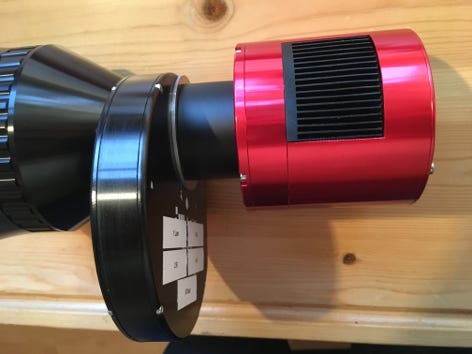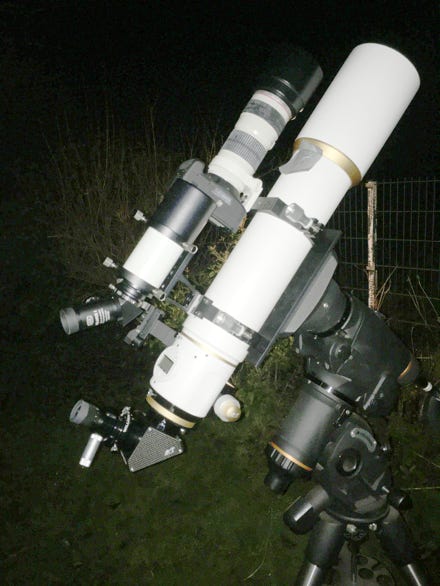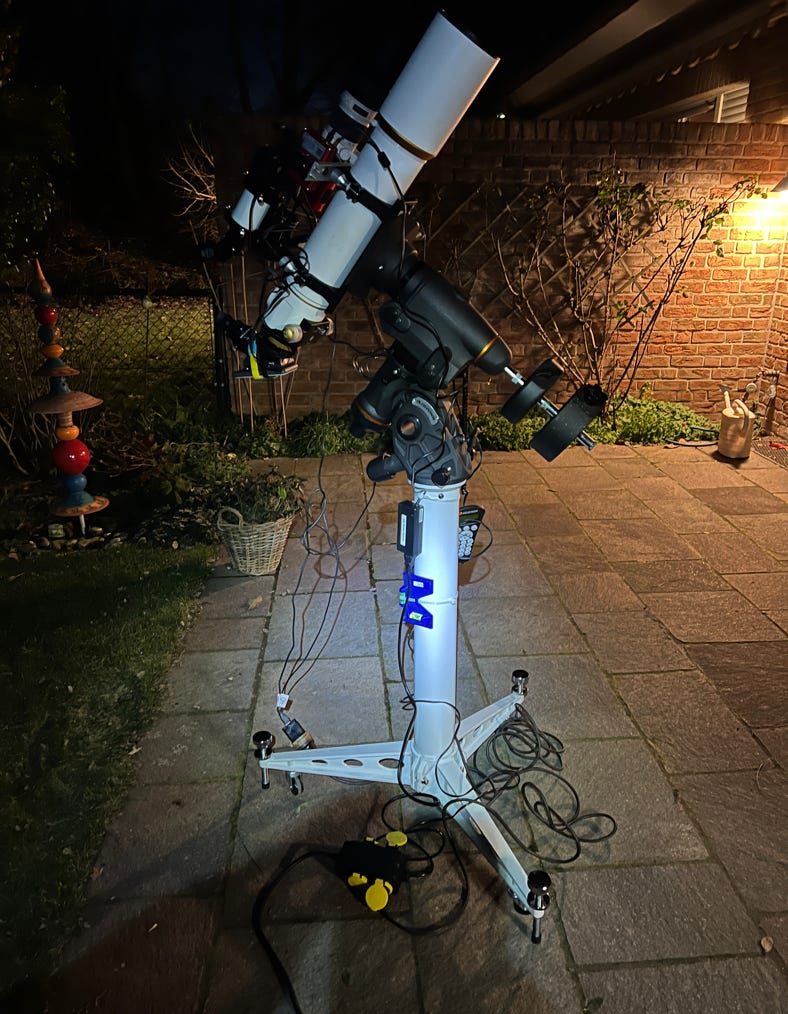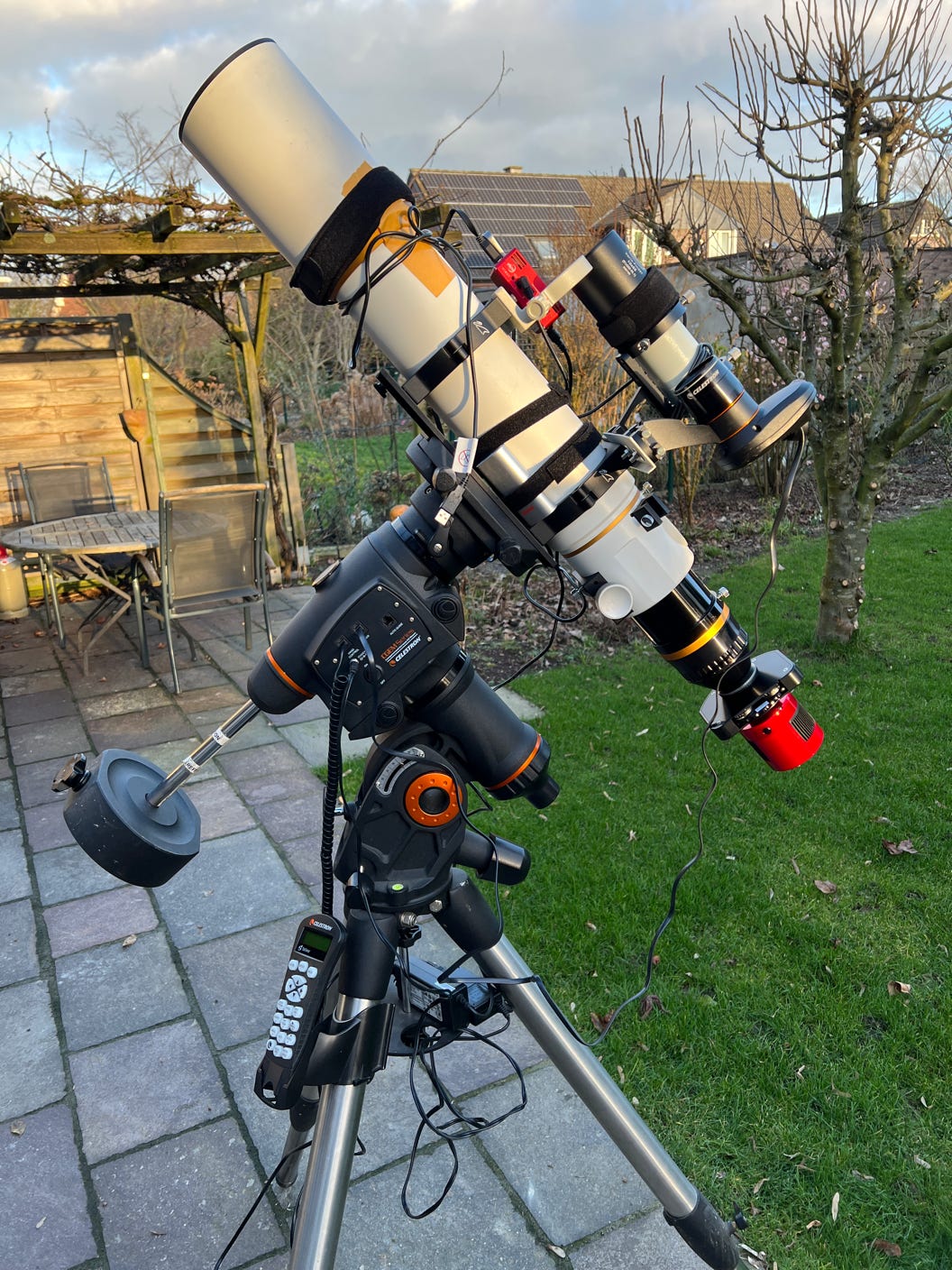Equipment

The William Optics110 FLT triplet APO refractor, f/7

The 8” Dobson (f/4) made by Hofheim Instruments


My William Optics110 FLT triplet APO refractor, f/7, on the Celestron CGEM mount, together with a finder-scope and a telelens.
The ASI1600mmpro with William Optics Flattener and ATIK Filterwheel
During the recent years I bought two telescopes: One scope mainly for visual astronomy (although you can obtain good prime-focus photography too, see later...): a superb 8” Dobson (f/4), made by Hofheim Instruments , a great scope, in particular ideal for easy traveling to sites which are less light polluted.
And, more recently, for astrophotography, a 110 mm apochromatic refractor (f/7) made by William Optics, mounted on a Celestron CGEM german GoTo mount. This scope was my dream since I began my hobby: a high-end refractor on a stable mount with GoTo functionality (although I am still able to find M13 with my Dobson using a star …map) but it is so comfortable....
If I want to take photos, I am using my DSLR Canon 450 EOS, or the astro-modified Canon EOS 600 D, or the monochrome CCD camera DMK 31AU03.AS made by The Imaging Source . This is a great camera which also works in the prime focus of my Dobson, either un-guided (see the moon in my gallery), or mounted on the CGEM. Very useful is the Canon tele-zoom lens EF 70-200 mm, f/4L, USM. And.... of course.... many important accessories like filters, eyepieces, adapters..... And lately I obtained the Lacerta M-Gen autoguider. It works perfectly in combination with the CGEM mount and the Canon DSLR. The guider and other very useful accessories I obtained through Teleskop-Service.
Long exposures (> few seconds) require the CGEM mount, star- and polar-aligned and the autoguider, see, for example, the globular cluster M13, or the North America Nebula.
The pictures below show the usual telescope set-up used for observing nights.


The William Optics 110 mm APO FLT f/7 refractor in my garden in Vorst (D) mounted on a Celestron CGEM go-to equatorial mount. The Canon EOS 600D DLSR camera is in the prime focus behind a flattener. Visible also the (60x250) mm finder-scope with the Lacerta M-Gen auto-guider CCD.
The telescope in Kempen, on a new tripod, this time with the ASI1600mm pro attached to the Canon 70-200 telelens.
The handcontrol (Nexstar) has been recently replaced by the Celestron StarSense handcontrol which operates the new StarSenseModule (not shown on the picture). This new CCD modul (in fact a small wide-angle camera) helps aligning the telescope semi-automatically by collecting and analyzing sky images. In addition, polar alignment and auto star alignment with additional reference fields produce a very accurate, convenient and fast alignment for astrophotography. This new StarSense-Modul replaced the old CGEM Nexstar procedure for a manual 2-star alignment with calibration stars and additional polar alignment.

Shown on this picture, taken in Vorst, ist the William Optics refractor, this time with a diagonal mirror and eyepiece, as well with diagonal and eyepiece in the finder-scope. Behind the finder is the Canon EF 70-200 mm L USM f/4 telelens with Canon EOS 600D DSLR, mounted as “piggy-back on the refractor.

The set-up in Kempen, used for pictures taken starting in Spring 2022. The William Optics refractor, with flattener, LRGB filter wheel and ASI1600mm pro camera. In front of the finder (guide scope) is the Celestron StarSense Module used for star and polar alignment of the telescope. The red box near the top of the refractor is the ASIAIR pro device to control the ASI camera, and to store the images. (Work is in progress to optimize the cable-spaghetti)
Early 2023 I bought a very useful accessory for the refractor: an electronic auto focuser (EAF). This device was mounted to the refractor (right) and it controls the focus setting using a precise stepping motor. Once a reasonable focus has been reached, a separate auto-focus routine (operated through the ASIAIRpro) very precisely and quickly determines an exact focus. See, for example, the 2023 images of NGC 2244 (Rosette Nebula) showing perfectly round field stars. Auto-focus should be applied before every target run, for each filter and after temperature changes, or, optionally, every hour.


The new auto guider ASI120mm mini with the Baader 60x250 mm viewfinder.
A very important accessory is the “Autoguider”, a small electronic device used as a detector connected to the view finder. This camera measures the positions of field stars near the target continuously during the exposure of a single light frame (“picture”, typically 120 sec). The tracking of the CGEM mount to compensate for the Earth rotation is never perfect, so small deviations of the pointing (in both directions) will be corrected in real-time by the Autoguider which is sending its signals to the CGEM mount. This keeps the telescope pointing with sufficient accuracy, the telescope “guides itself” during the exposure (“auto-guiding”).
In August 2023 I replaced my old, faithful auto guider Lacerta Mgen II by the new ASI120mm mini.
Shown in the picture below is a typical screen while “Auto-guiding” is active. The auto-guider locks on a guide star. The picture shows the corrections as a function of time for right ascension (blue) and declination (red), thereby compensating small guiding errors of the order of about 1” (one arc second = 1/3600 of a degree).
